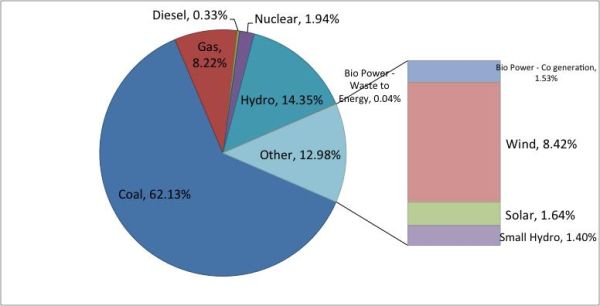According to the 2011 Census, 31% of the country is ‘urban’. Using definitions of urbanisation that are different from those used by the government, this column demonstrates that this figure may be an underestimate. It is important to recognise and fix the flaws in the current method of defining urban areas as it forms the basis for important policies such as eligibility for government schemes.
According to the 2011 Census, India is 31% urban – a statistic that is much-relied on to shape development strategies and perceptions about the country. The percent of India governed as urban – that is, administered by urban local bodies such as municipal corporations – is even lower. In recent research, we compare the urbanisation rate of India using the two government definitions – the administrative definition and Census definition – which can be discretionary in nature, with two alternative definitions that make use of objective population threshold criteria (Tandel, Hiranandani and Kapoor 2016). We argue that alternative definitions are better suited than the administrative definition used by the government to determine policies like eligibility for Mahatma Gandhi National Rural Employment Guarantee Act (MNREGA).
Administrative and census definitions
State governments ultimately determine the administrative status of settlements. The default category of a settlement is rural and it becomes urban only after the state government converts it following a requisite legal process. Although there are guidelines that propose population and other criteria in order for settlements to be governed as urban, these are not binding on state governments. As a result, the decisions to convert settlements from rural panchayats to urban local bodies can be arbitrary and may vary across states. There may even be pressures or incentives (such as being able to access rural schemes) to not convert settlements to the urban category, even when they are de facto urban in nature.
The Census of India acknowledges the existence of settlements that are de facto urban but are governed as rural by creating a category called “Census towns” to identify such settlements. The criteria for being a Census town are having a population of at least 5,000, density of at least 400 persons per square kilometer, and at least 75% of the male main1 working population engaged in non-agricultural activities. However, contrary to common perception, even the Census uses discretion in actually identifying these towns (Pradhan 2013). The Census includes these Census towns together with settlements that are urban as per the administrative definition in its definition of urban.
Alternate definitions based on population criterion
As a counterpoint to the administrative definition and the census definition of urban, we study how the scenario would change if India used a population criterion of 5,000 or a population criterion of 2,500 for defining urban. These definitions are used by countries such as Ghana, Qatar, Mexico and Venezuela2.
We find that while India is only 26% urban using the administrative definition, it is 31% urban by the census definition, 47% urban by the 5,000 population definition, and 65% urban by the 2,500 population definition. The differences in urbanisation rates using different definitions are even starker at the state level. For instance, Kerala goes from being 15% urban by the administrative definition to 99% urban by the 5,000 and 2,500 population definitions.
Urbanisation rates and socioeconomic indicators
It is difficult to find a precise definition that could capture the true nature of all places. However, studies like Buckley et al. (2009) and Khan (2000) have established a link between urbanisation and socioeconomic indicators, and one way to assess the suitability of various urban definitions is to examine the relationship of urbanisation rates using different definitions with these socioeconomic indicators. In a system that justifies special treatment to rural areas because they are thought to be more deprived or agrarian, an examination of the relationship between the chosen definition and development or agricultural indicators is warranted.
We conduct a state-level comparison of the relationship between urbanisation rates as measured by the administrative, Census, and alternative definitions, and poverty rates, per capita net state domestic product, and share of working population engaged in agriculture and cultivation. We find that the census definition and 5,000 population definition have a stronger relationship with these characteristics as compared to the administrative definition.
Eligibility for government schemes
Using inaccurate definitions of urban and rural can be costly since, among other reasons, these categories are used as the basis for determining eligibility for various state and central government schemes, and standards of public goods and services delivery. For instance, MNREGA – the world’s largest employment guarantee programme in terms of number of beneficiaries (Honorati, Gentilini, and Yemtsov 2015) – makes use of the administrative definition to identify rural areas and allocate funds to them. A faulty or arbitrary way of defining settlements as rural implies that there is arbitrariness in the way in which people across the country are eligible to an employment guarantee. There is also a possibility that MNREGA funds are being allocated to settlements that are actually urban but are classified as rural by the administrative definition.
We compare the use of MNREGA – which has in-built self-selection mechanisms of providing unskilled manual work at close-to minimum wage so that only the most deprived people demand it – with the four urban definitions, and find a surprising trend. According to the administrative definition, more urban states3 make more use of the scheme, while according to the other three definitions more rural states make more use of the scheme.
Figure 1. Relationship between MNREGA expenditure and urbanisation in Indian states and Union Territories (UTs)
 Note: Eligible population is urban population when using the administrative definition.
Note: Eligible population is urban population when using the administrative definition.
This observation prompted us to undertake a district-level study of the relationship between urbanisation rates and MNREGA use. We control for other factors that could affect MNREGA use such as state-level effects, district development indicators, and political characteristics. We find that when using the administrative definition, more urban districts make more use of MNREGA, whereas using the 5,000 and 2,500 population definitions, more rural districts make more use of MNREGA.
There may be several explanations for this. For instance, district administrative staff of more administratively urban districts may be more adept at using government resources, or information asymmetries may be less in more urban districts leading residents to demand more of government schemes. However, we believe that it is more plausible that the relationship indicates that the administrative definition is a poor indicator of the urban character of the district. This is supported by the fact that alternative definitions relate better with development indicators, and that we do not find evidence that more rural districts by the administrative definition as compared to alternative definitions (in other words, districts in which the administrative definition overestimates rural rates to a greater extent) make more use of MNREGA. This suggests that the scheme’s self-selection mechanisms broadly work in this respect.
Recognise and fix flaws in current urban definitions
Taken together, the results present a strong case that alternative definitions of urban are better suited than the administrative definition to reflect the urban character of settlements in India.
A precise and perfect method for defining urban and rural areas may be difficult and costly. Therefore, it may be more prudent to reduce the stakes of such definitions, to make definitions more reflective of ground realities, and to reduce the scope for political exploitation of subjective categorisation.
One way to reduce the stakes of definitions is to use objective criteria such as poverty rates and proportion of agricultural workers to determine eligibility for government schemes and policies and access to social services, wherever possible. Where this is not possible, instead of a standard definition for all scenarios, it may be worthwhile to explore using different definitions to determine eligibility for particular programmes. Such an approach is used in countries like the United States and the United Kingdom, where different concepts of rural are used for different government programmes, depending on their objectives.
However, there is still merit in moving towards a more accurate and general definition of urban since characteristics such as population and population density themselves alter the nature of places and prospects of their residents, justifying the need to treat places differently. Hence, while we adapt and reduce reliance on urban-rural categorisation, it is also important to recognise and fix the flaws in India’s current method of defining urban areas.
Notes:
- Main workers are defined by the Census as those who “worked for the major part of the reference period (six months or more)”, as opposed to marginal workers.
- More countries, like Argentina and Ethiopia, use a 2,000 cutoff rather than 2,500, but we use the more conservative number as threshold.
- More urban states, by the administrative definition, are states with a higher proportion of their population living in settlements that are categorised as urban by the administrative definition.
Further Reading
- Honorati, M, U Gentillini and R Yemtsov (2015), ‘The State of Social Safety Nets 2015’, World Bank Group, Washington D.C.
- Pradhan, Kanhu Charan (2013), “Unacknowledged Urbanisation: New Census Towns of India”, Economic and Political Weekly, 48(36):43-51. Available here.
- Spence, M, P Annez and R Buckley (eds.) (2009), ‘Urbanization and Growth’, Commission on Growth and Development, World Bank.
- Khan, M (2000), ‘Rural Poverty in Developing Countries: Issues and Policies’, IMF Working Paper No. 00/78.
- Tandel, V, K Hiranandani and M Kapoor (2016), ‘What’s In A Definition?: A Study on Implications and Suitability of Urban Definitions in India through its Employment Guarantee Programme’, Working Paper Series, IDFC (Infrastructure Development Finance Company) Institute.




 15 September, 2016
15 September, 2016 






Comments will be held for moderation. Your contact information will not be made public.